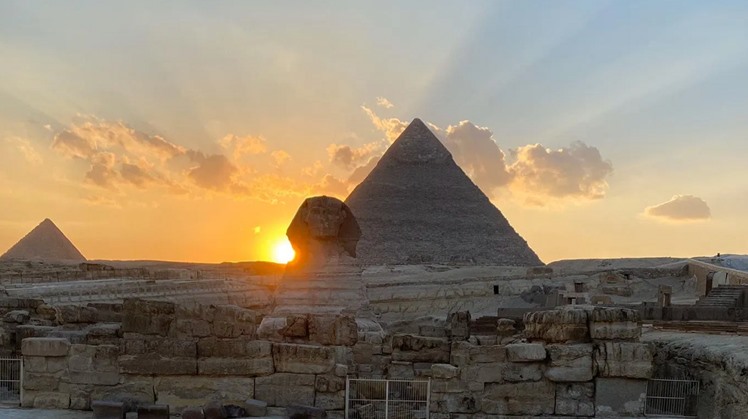The city of Abu Simbel in southern Egypt witnessed the phenomenon of the sun perpendicular to the face of King Ramses II in his great temple in Abu Simbel, and it is the unique astronomical phenomenon that millions around the world await to witness the miracle of the ancient Egyptians in the embodiment of such astronomical calculations. October 22, and the phenomenon lasts for only 20 minutes.
The sun's rays infiltrate the main hall to illuminate the statues located in the deepest part of the temple, ie the Holy of Holies, where four goddesses, Amun-Re, Re-Harakhty, Ptah, and Ramses II as a deity sit. The Abu Simbel Temple in Aswan Governorate is one of the most famous archaeological temples in Egypt, due to its association with the phenomenon of the sun perpendicular to the face of the statue of Pharaoh Ramses II in the Temple’s Holy of Holies twice a year. And "Ptah" and "Ramses II" as an idol. As for the smaller temple to the north, it was dedicated to the goddess "Hathor" and Queen "Nefertari".
But it seems that the phenomenon of the sun’s perpendicularity is not limited to Aswan Governorate, where many temples witness pictures of the sun perpendicular to it on specific dates that are repeated annually, witnessing the ancient Egyptian’s mastery of astronomy and engineering, and that is other archaeological sites in different regions of the republic’s governorates on Throughout the year, and among the most prominent of those sites that witness the phenomenon:
Sphinx face
On the two equinoxes, a strange and beautiful phenomenon can be observed, which is the sun perpendicular to the statue of the Sphinx in Giza. Behind the southern side of the great pyramid of King Khafre, at sunset, according to Dr. Zahi Hawass, the sun perpendicular to the Sphinx, three times a year, on March 21-22, as well as on September 21-22 of each year, i.e. in spring and autumn, and this is what is called Equinox, meaning when night equals day. I have celebrated this day for five years, and at sunset we find that the sun descends at sunset on the right shoulder of the Sphinx directly, and during the summer we find that the sun begins to move to the north and in the winter it moves to the south.
Hebes Temple
With the sun perpendicular to the Holy of Holies in the Temple of Hibis, in the city of Kharga in the governorate, which is one of the most famous monuments and the only one remaining in Egypt from the Sawy and Ptolemaic eras, and this phenomenon occurs twice a year (on April 7 and September 6), as the sun rays infiltrate the entrance to the main temple at an angle 82.6 degrees clockwise.
Qarun Temple
The sun perpendicular to the Holy of Holies in the Qasr Qarun Temple, which occurs at the dawn of the twenty-first of December every year. The sanctuaries, which are supposed to contain the sacred boat of the god Sobek, turn right and illuminate the right compartment, which contained the statue of the god, while the left compartment remains immersed in darkness, as it contained the mummy of Sobek the crocodile.
Karnak Temple
The sun perpendicular to the Karnak temples gradually until it reaches the Holy of Holies in the Karnak Temple, on December 21 of each year, from six to eight in the morning. The ancient Egyptians represented the beginning of winter time, as well as the great birthday of Ra, a phenomenon that reflects an aspect of the greatness of The ancient Egyptian, who was closely familiar with astronomy and the movement of the sun, began monitoring the phenomenon for the first time in history in the nineteenth century, and to this day it has become one of the most important tourist and archaeological events in the tourist governorate of Luxor.
 Mon, Oct. 24, 2022
Mon, Oct. 24, 2022